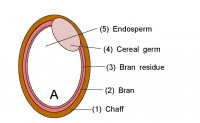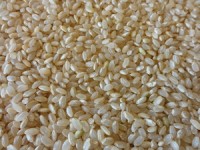Beneficial properties of whole grains
 Grains have three main parts: bran, germ and endosperm. Bran is very rich in fiber, fatty acids, vitamins and minerals. Germ contains proteins, B vitamins, antioxydants and phytonutrients. Endosperm or starch contains carbohydrates and proteins.
Grains have three main parts: bran, germ and endosperm. Bran is very rich in fiber, fatty acids, vitamins and minerals. Germ contains proteins, B vitamins, antioxydants and phytonutrients. Endosperm or starch contains carbohydrates and proteins.The bran of grains is composed of cellulose, pectins, lignin, wax, inulin, oligosaccharides and mucilages, substances that can’ be digested nor absorbed by our body, so they get to the large intestine to be eliminated. In the large intestine they suffer a fermentation by some bacteria, and some beneficial substances are produced: short chain fatty acids and gas such as carbon dioxyde, methane and hydrogen. The short chain fatty acids help avoiding colon cancer. And it’s very well known that bran helps defecate, by absorbing water and adding bulk to stools.
There are two different types of fibers: soluble and insoluble, depending on their capability of water solubility. Most of soluble fibers attract water and form a gel which is fermented by gut bacteria. It also slows down digestion of starch and prevents spikes in blood sugar, so avoids the hypoglycemia-hyperglycemia cycle due to the fluctuant level of insuline. Insoluble fibers don’t dissolve in water, most of them are not fermented and speed up the passage of food and waste thought the gut, helping prevent constipation.
All plant foods contain both types of fiber in different degrees, but mainly starchy food such as pulses, some fruits and tubers contain a higher proportion of soluble fibers, while most of cereals, vegetables, fruit and nuts contain more insoluble fibers, so they help fighting against constipation.
Upon this information, whole grains are presumably higher nutritional value. And this is true in healthy people, but it’s not the case in people with an unbalanced gut flora.
People that suffer some kind of chronic disease, even the ones that are sick from time to time, have a overgrowth of undesirable bacteria in the intestine (yeasts, fungi, clostridium, coliforms, etc.) and decreased amount of beneficial bacteria (lactobacilli, bifidus, etc.). In this case, fiber, mainly the soluble one, isn’t fermented by the beneficial bacteria, but by the undesirable bacteria, resulting in the production of toxins and gas that poison the body.
Insoluble fibers can be irritant to persons that have soft stools, diarrhoea, irritable bowel syndrome and crohn’s disease.
Anti-nutrients
Grain bran contains an anti-nutrient called phytic acid. Humans, opposite to ruminant animals, don’t produce phytase, the enzyme that digests phytic acid, excepting people that possess a perfect gut flora that can produce a little bit of this enzyme. Phytic acid binds to minerals such as iron, magnesium, calcium and zinc, to form phytates, allowing the flush of this substances by urine. So phytic acid is a demineralising substance, this is, avoids the proper absorption of minerals in the body. And even more, phytic acid also inhibits the action of some enzymes, which are needed to digest food, such as pepsin and trypsin to digest proteins and amylase to digest starch. Also, it prevents also the absorption of vitamin B3 or niacin present in germ, which deficiency is the origin of a disease called pelagra.
On the other hand, some experts suggest that phytic acid protects against diabetes, caries, atherosclerosis and heart disease. Also, phytic acid inhibits free radical formation, acting as antioxidants. It seems to chelate the heavy metals off the intestine, too. (5)
Other anti-nutrient substances that exist in the grain bran are the oxalates, which are demineralising substances too, tannins, polyphenols, hemagglutinins and lectins. These substances are part of the natural protection of grains against insects and fungi and the preservation of grains for germination.
Some scientific experiments have shown that although whole grains have a higher amount of minerals, the final amount of absorbed minerals by the person is lower in whole grains, because of the action of the phytic acid and the other anti-nutrient substances.
To reduce these substances in grains, you may soak or sprout them before cooking them. Fermentation, such as traditionally made sourdough bread, also helps reducing phytates. Also it does roasting grains or nuts. Thanks to these processes, it’s possible to increase the absorption of minerals in these foods up to 12 times for the iron, for example.
These methods were traditionally used in most of cultures with a grain based diet: sourdough bread, idli, miso, tapai, etc. The explanation is that phytase naturally existing in grains allows the break down of phytic acid when they are soaked, sprouted or fermented before cooking them. But cooking destroys this enzyme.
Concerning oxalates, these are considerably reduced too when soaking grains, but the process that better removes oxalates is boiling with water.
These anti-nutrient substances are also present in nuts, pulses, cocoa and all kind of seeds, so the same process can be made to them to decrease the anti-nutrient content: soaking, sprouting, fermentation and roasting. Potatoes and sweet potatoes have lower content of phytates, but it’s not possible to apply the traditional methods to reduce the phytates. Also some fruits, such as dates, avocado and mango have phytates in smaller amount. The kind of fertilisers have also an impact on the amount of phytates of vegetables and grains, depending on the amount of phosphate in the composition.
On livingglutenfree.com you can find more information about how to remove phytic acid of grains, nuts and pulses.
Refined grains
Refined grains have been submitted to an industrial process to take fiber and germ away of the grain, keeping just the starch. In the XVII century grains began being refined with the goal of increasing the conservation time and caloric content, because the fatty acids present in fiber and germ suffer a quick oxidation. As natural, products with higher nutritional content spoil faster than empty nutritional products. And sweet taste of carbohydrates is better appreciated than the fibrous texture of bran, so humans have been easily adapted to refined grains.
The problem of refined grains is that they lack vitamins, minerals, fatty acids and antioxidants, so it’s not a whole nutritional food and they can’t be the base of the nutrition of a population, in contrast to whole grains. Some refined grains are enriched with certain vitamins, however, refined grains still lack some nutrients found in whole grain (for example, fibre, fatty acids and magnesium). (1)
Other substances in grains
Another important issue to take into account are pesticides. Bran is the part of the grain that concentrates all pesticides that the grain has been submitted to, so non-organic grains have a very much higher rate of this chemical substances.
So both whole grains and refined ones seem to have disadvantages. What about all grains in general? May we call into question the myth of grain being healthy?
One fact about all grains is that the type of fatty acid they contain is omega6, which is an inflammatory fatty acid. Occidental population have an excessive intake of omega6. Ideally, the ratio of omega6 vs. omega3 should be 1:1, but nowadays the average ratio is about 15:1. Too much cereals, pizza, pasta, bread, cakes, grain feed or non-pasture raised meat and omega6 rich oils in cooking such as corn, sunflower, soy, sesame and peanut. Al this together with a deficiency of wild cold water fish and vegetables, which are rich in omega3, an anti-inflammatory fatty acid. Omega6 is related with cardiovascular diseases, asthma, rheumatoid arthritis, cancer, diabetes, psychiatric disorders and other inflammatory, auto-immune and neurological diseases.(6)
Another fact to take into account is the possible enzymatic intolerance to carbohydrates due to a deficiency of the amylase family of enzymes which digests carbohydrates. Or an overgrowth of yeasts such as Candida in the intestine, which produces toxins such as ethanol when is fed by carbohydrates and sugars. Some of this toxins are responsible of a wide range of health problems that goes, again, from neurological to auto-immune diseases. (7) (8)
If the main reason for consumption of whole grains is fiber, then it’s better to have fruit and vegetables, they are a more suitable kind of source of fiber. Fruit and vegetables don’t contain anti-nutrients and they are higher in fiber, minerals, vitamins, omega3 and antioxidants. And they are also a source of energy because their fructose, saccharose and starch content.
Conclusion:
Whole grains have some pros and cons. Probably, people that enjoys good health can have it without major problems, only if they are organic and they follow the traditional process to prepare them before cooking. But I don’t recommend them for people that present any kind of gastrointestinal disease or suspect a gut flora unbalance.In case of suffering any kind of disease, I would advice considering avoiding all kind of grains.
Sources:
(1) “In defense of food”, Michael Pollan
(2) “Living With Phytic Acid”, http://www.westonaprice.org/food-features/living-with-phytic-acid
(3) “Functional properties and anti-nutritional factors in cereal bran” http://www.ajofai.info/Abstract/Functional%20properties%20and%20anti-nutritional%20factors%20in%20cereal%20bran.pdf
(4) “Phytic Acid. Tips For Consumers From Food Science” http://www.phyticacid.org/
(5) “All About Phytates” http://www.precisionnutrition.com/all-about-phytates-phytic-acid
(6) “The importance of the ratio of omega-6/omega-3 essential fatty acids.” http://www.ncbi.nlm.nih.gov/pubmed/12442909
(7) “Grain Brain”, David Perlmutter, MD
(8) “Gut and Psychology Syndrome”, Natasha Campbell-McBride, MD
 Whole foods are currently fashionable. Most diet food for loosing weight made of cereal is rich in bran, which comes from the same cereal or from added bran.
Whole foods are currently fashionable. Most diet food for loosing weight made of cereal is rich in bran, which comes from the same cereal or from added bran.







 Gemma Calzada is a Holistic Nutritionist Ph.D. and a certified GAPS practitioner, accredited by ASCA. Her mission is to improve health through nutrition and to help people suffering from a dietary intolerance to live happily.
Gemma Calzada is a Holistic Nutritionist Ph.D. and a certified GAPS practitioner, accredited by ASCA. Her mission is to improve health through nutrition and to help people suffering from a dietary intolerance to live happily. 
